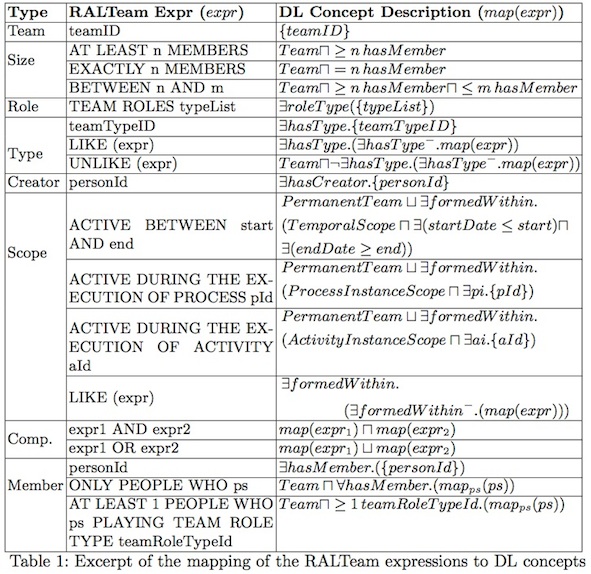RALTeam semantics
Following the same approach as in RAL, RALTeam semantics is defined by means of a mapping to DLs. Knowledge representation systems based on DLs involve two components: TBox and ABox. The TBox describes terminology, i.e., the ontology in the form of concepts and roles (relations between the concepts) and their relationships, while the ABox contains assertions about individuals (instances of concepts) using the terms from the ontology. The mapping has three elements: the team-aware organisational metamodel, its instantiation for a specific organisation and the RALTeam expressions themselves.
The mapping of the team-aware organisational metamodel is straightforward: metamodel classes and associations are mapped as concepts and roles in the KB, respectively, and cardinality restrictions are mapped as axioms. There is only one consideration to this mapping. In the metamodel, the relationship between Person, Team and TeamRoleType is modelled with class TeamRole. However, DLs allows a more convenient way of expressing such a relationship by using hierarchies of roles. Therefore, in this case the mapping involves adding a role hasMember from Team to Person and defining each TeamRoleType as a new subrole of hasMember. In addition, a new role roleType is added from Team to TeamRoleType.
The mapping of the instantiation of the metamodel is done as follows. In this case, class instances and their relations are mapped as individuals and relations between them except for TeamRole instances, which are mapped by means of hasMember subroles as described above. In addition, the mapping should include assertions that explicitly state that each individual has exactly the roles specified and no more (e.g. Team Perm_RE_1 has exactly two hasMember relationships). This is a technical detail that is necessary to deal with the open world assumption of \dls. The open world assumption means that \dls assume that the knowledge may be incomplete and, hence, the absence of a role assertion stating that hasMember(Perm_RE_1, Jane) does not mean that Jane does not belong to team Perm_RE_1.
Finally, RALTeam expressions are mapped into DL concept descriptions. These concept descriptions are all subconcepts of Team and are defined in a way such that the following condition holds:
Teams defined by RALT eamExpr ≡ individuals(map(RALT eamExpr))
where individuals is a well-known DL operation that returns all the individuals that are instances of a DL concept and map is a function that maps RALTeam expressions to DL concept descriptions. This means that all RALTeam expressions can be formulated in terms of DLs and automatically resolved by means of a DL reasoner. The tables below detail the mapping for most RALTeam expressions. Expressions that involve RALTeam Member require an additional mapping (see the table on PeopleSelection) to obtain DL concepts from people selection expressions. All of these mappings have been tested using the HermiT OWL reasoner. Furthermore, a proof-of-concept application to automate them has also been implemented using Java and the OWL API.














